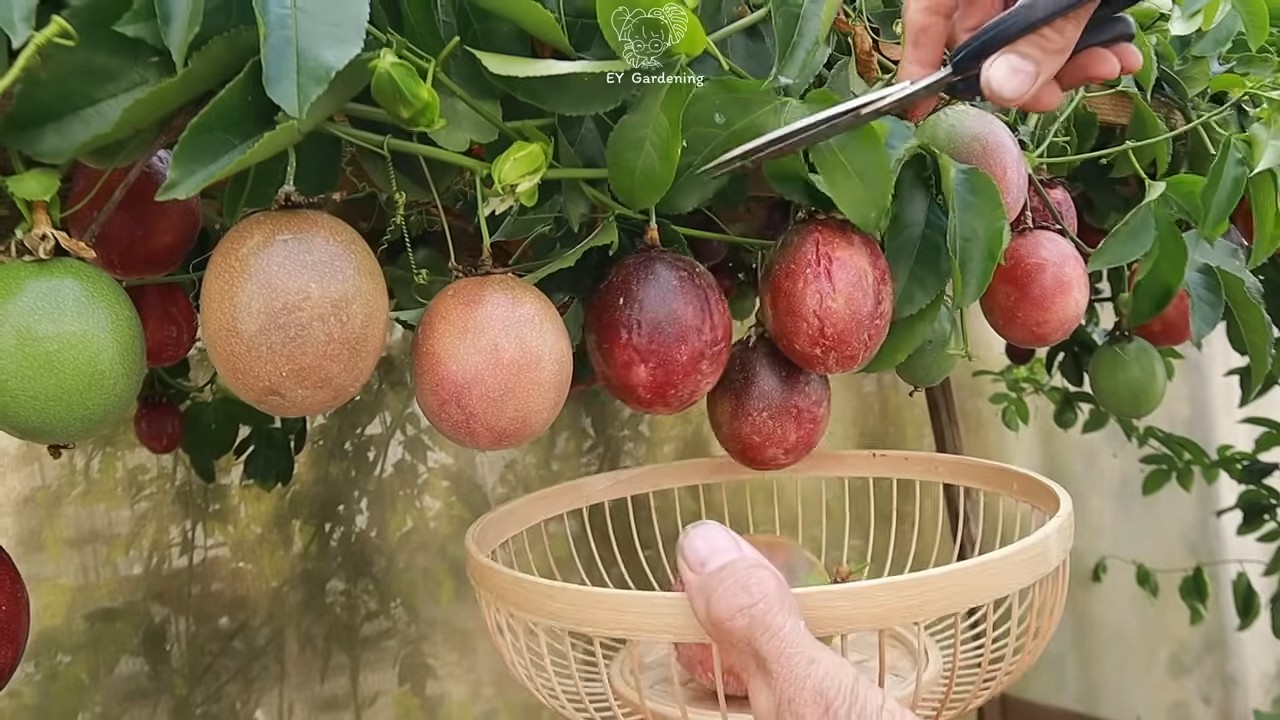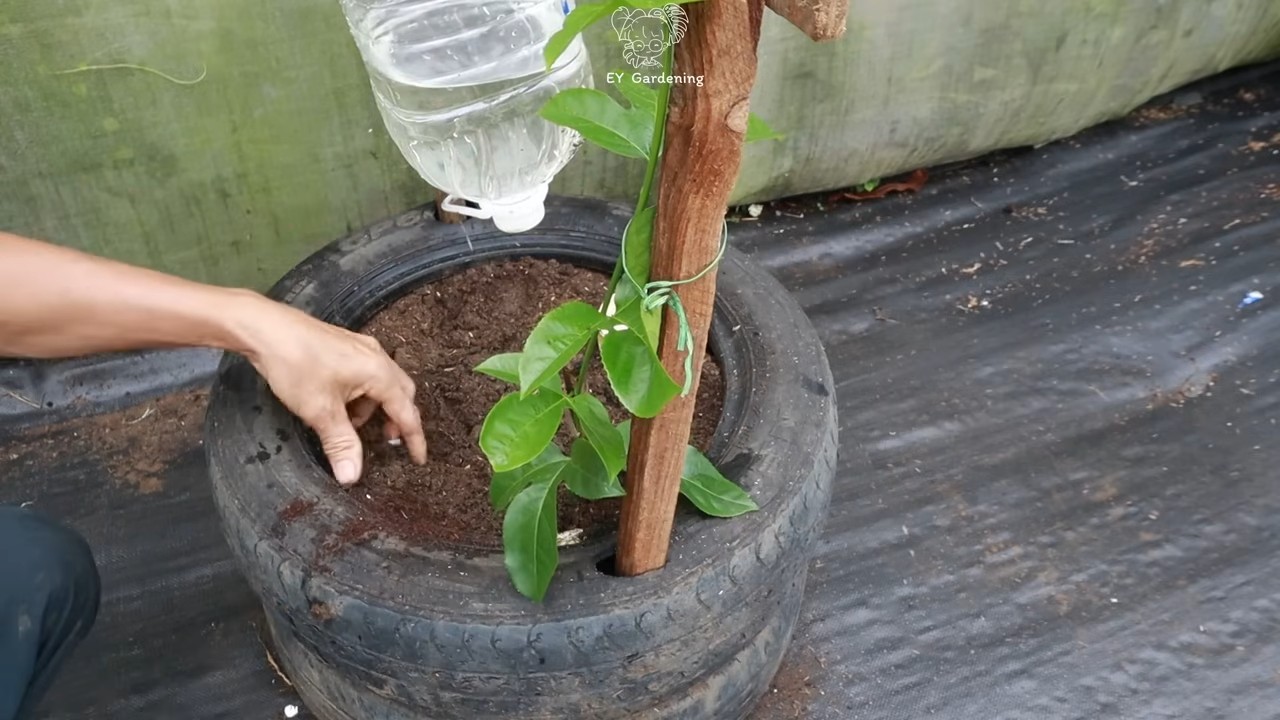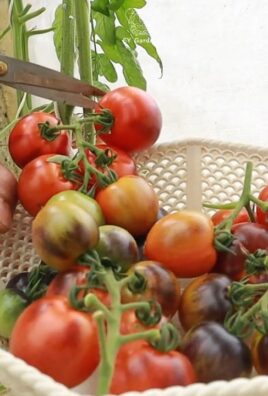Grow Passion Fruit at Home and transform your garden into a tropical paradise! Imagine stepping outside and plucking a perfectly ripe, fragrant passion fruit straight from your own vine. Sounds dreamy, right? Well, it’s more achievable than you might think, and I’m here to show you how with some simple DIY tricks and hacks.
Passion fruit, with its vibrant flavor and exotic aroma, has a rich history deeply rooted in South American culture. For centuries, indigenous communities have cherished this fruit not only for its delicious taste but also for its medicinal properties. Now, you can bring a piece of that history to your own backyard!
Why should you bother learning how to grow passion fruit at home? Well, store-bought passion fruit can be expensive and sometimes lack the intense flavor of a vine-ripened fruit. Plus, there’s nothing quite like the satisfaction of nurturing a plant from a tiny seedling to a bountiful producer. This DIY guide will provide you with the knowledge and confidence to successfully cultivate your own passion fruit vine, even if you’re a complete beginner. I’ll share my favorite tips and tricks for choosing the right variety, providing optimal growing conditions, and troubleshooting common problems. Get ready to enjoy a taste of the tropics, right from your own garden!

Growing Passion Fruit at Home: A DIY Guide to Tropical Delights
Hey there, fellow plant enthusiasts! Ever dreamt of having your own little slice of the tropics right in your backyard (or even on your balcony)? Well, dream no more! Growing passion fruit at home is totally achievable, and I’m here to guide you through every step of the process. It might seem a bit daunting at first, but trust me, the reward of harvesting your own sweet and tangy passion fruit is absolutely worth it. So, let’s get started!
Choosing the Right Passion Fruit Variety
Before we dive into the nitty-gritty, it’s crucial to pick the right passion fruit variety for your climate. Some varieties are more cold-hardy than others, so doing a little research beforehand will save you a lot of heartache later.
* Purple Passion Fruit (Passiflora edulis): This is the most common variety and generally does well in warmer climates (USDA zones 9-11). It’s known for its intensely fragrant flowers and delicious, tart fruit.
* Yellow Passion Fruit (Passiflora edulis flavicarpa): This variety is a bit more tropical and prefers consistently warm temperatures. The fruit is larger and more acidic than the purple variety.
* Frederick Passion Fruit: This is a hybrid variety that’s known for its large, flavorful fruit and good disease resistance. It’s a great option if you’re looking for something a little more robust.
Tip: Check with your local nursery or agricultural extension office to see which varieties are best suited for your specific region.
Preparing for Planting
Okay, so you’ve chosen your variety. Now it’s time to get everything ready for planting. This involves selecting the right location, preparing the soil, and setting up a support system.
* Sunlight: Passion fruit vines need at least 6-8 hours of direct sunlight per day to thrive. Choose a spot in your yard that gets plenty of sunshine.
* Soil: Passion fruit prefers well-draining soil that’s rich in organic matter. Amend your soil with compost or aged manure to improve its fertility and drainage. A slightly acidic soil pH (around 6.0-7.0) is ideal.
* Support System: Passion fruit vines are climbers, so they need a sturdy support system to grow on. This could be a trellis, fence, arbor, or even a strong pergola. Make sure the support is strong enough to handle the weight of a mature vine laden with fruit.
Step-by-Step Planting Guide
Alright, let’s get our hands dirty! Here’s a step-by-step guide to planting your passion fruit vine:
1. Dig the Hole: Dig a hole that’s twice as wide and just as deep as the root ball of your passion fruit plant.
2. Amend the Soil: Mix some compost or aged manure into the soil you removed from the hole. This will provide your plant with essential nutrients.
3. Remove the Plant from its Container: Gently remove the passion fruit plant from its container, being careful not to damage the roots. If the roots are pot-bound (tightly circling the root ball), gently loosen them with your fingers.
4. Plant the Vine: Place the plant in the hole, making sure the top of the root ball is level with the surrounding soil.
5. Backfill the Hole: Fill the hole with the amended soil, gently tamping it down around the plant.
6. Water Thoroughly: Water the plant thoroughly after planting to help settle the soil and encourage root growth.
7. Mulch: Apply a layer of organic mulch (such as wood chips or straw) around the base of the plant to help retain moisture, suppress weeds, and regulate soil temperature. Be sure to keep the mulch a few inches away from the stem to prevent rot.
8. Train the Vine: Gently guide the vine towards your chosen support system and tie it loosely with soft twine or plant ties. As the vine grows, continue to train it along the support.
Caring for Your Passion Fruit Vine
Once your passion fruit vine is planted, it’s important to provide it with the proper care to ensure healthy growth and abundant fruit production.
* Watering: Passion fruit vines need regular watering, especially during dry periods. Water deeply whenever the top inch of soil feels dry to the touch. Avoid overwatering, as this can lead to root rot.
* Fertilizing: Feed your passion fruit vine regularly with a balanced fertilizer. Apply fertilizer every 4-6 weeks during the growing season (spring and summer). Follow the instructions on the fertilizer label for application rates. I like to use a fertilizer specifically formulated for fruiting plants.
* Pruning: Pruning is essential for maintaining the shape and productivity of your passion fruit vine. Prune in late winter or early spring, after the risk of frost has passed. Remove any dead, damaged, or diseased branches. Also, prune back any overly vigorous growth to encourage branching and fruit production.
* Pest and Disease Control: Keep an eye out for common pests and diseases that can affect passion fruit vines, such as aphids, spider mites, and fungal diseases. Treat any infestations or infections promptly with appropriate insecticides or fungicides. Organic options are always a good choice!
* Pollination: While some passion fruit varieties are self-pollinating, others require cross-pollination to produce fruit. If you’re not seeing fruit set, you may need to hand-pollinate the flowers. Use a small paintbrush to transfer pollen from one flower to another.
Harvesting Your Passion Fruit
The moment you’ve been waiting for! Harvesting your own passion fruit is incredibly rewarding.
* When to Harvest: Passion fruit is typically ready to harvest when the fruit changes color (from green to purple or yellow, depending on the variety) and falls to the ground. The fruit should also feel slightly heavy for its size.
* How to Harvest: Simply pick up the fallen fruit from the ground. You can also gently twist the fruit off the vine if it’s ripe but hasn’t fallen yet.
* Storing Passion Fruit: Passion fruit can be stored at room temperature for a few days or in the refrigerator for up to a week.
Troubleshooting Common Problems
Even with the best care, you might encounter some challenges along the way. Here are a few common problems and how to address them:
* Lack of Fruit: This could be due to a number of factors, including insufficient sunlight, poor pollination, or nutrient deficiencies. Make sure your vine is getting enough sunlight, consider hand-pollinating the flowers, and fertilize regularly.
* Yellowing Leaves: Yellowing leaves can indicate a nutrient deficiency, overwatering, or a pest infestation. Check the soil moisture, fertilize with a balanced fertilizer, and inspect the leaves for pests.
* Root Rot: Root rot is caused by overwatering and poor drainage. Make sure your soil is well-draining and avoid overwatering. If you suspect root rot, you may need to repot the plant in fresh soil.
Enjoying Your Homegrown Passion Fruit
Now that you’ve harvested your delicious passion fruit, it’s time to enjoy the fruits of your labor! Passion fruit can be eaten fresh, used in juices, smoothies, desserts, and sauces. The possibilities are endless!
Here are a few ideas:
* Eat it fresh: Simply cut the fruit in half and scoop out the pulp with a spoon.
* Make passion fruit juice: Blend the pulp with water and strain out the seeds.
* Add it to smoothies: Passion fruit adds a tangy and tropical flavor to smoothies.
* Make passion fruit curd: This is a delicious spread for toast or scones.
* Use it in desserts: Passion fruit can be used in cakes, pies, and ice cream.
Growing passion fruit at home is a truly rewarding experience. With a little patience and care, you can enjoy a bountiful harvest of delicious, tropical fruit. So, go ahead and give it a try! You might just surprise yourself with what you can grow. Happy gardening!

Conclusion
So, there you have it! Growing passion fruit at home isn’t just a whimsical dream; it’s an achievable reality with a little patience and the right approach. We’ve walked you through the essential steps, from selecting the perfect variety to nurturing your vine for optimal fruit production. But why should you embark on this journey? Because the reward is far more than just fresh fruit. It’s the satisfaction of cultivating something beautiful and delicious with your own hands. It’s the vibrant, tropical aroma that fills your garden as the flowers bloom. It’s the bragging rights of serving homemade passion fruit juice or adding a unique twist to your desserts with homegrown goodness.
This DIY trick, growing passion fruit at home, is a must-try for several compelling reasons. Firstly, the flavor of homegrown passion fruit is simply unparalleled. Commercially grown fruit is often picked before it’s fully ripe to withstand transportation, sacrificing some of its intense, tangy sweetness. When you grow your own, you can harvest it at its peak ripeness, ensuring an explosion of flavor with every bite. Secondly, you have complete control over the growing process. You can choose organic methods, avoiding harmful pesticides and herbicides, and ensuring that your fruit is as healthy as it is delicious. Finally, growing passion fruit is a sustainable practice. You’re reducing your carbon footprint by sourcing your food locally and contributing to a greener environment.
Looking for variations? Consider these ideas to personalize your passion fruit growing experience:
* Espalier Training: Train your passion fruit vine along a fence or wall for a visually stunning and space-saving display.
* Container Gardening: If you have limited space, grow your passion fruit in a large container. Choose a dwarf variety and provide adequate support for the vine.
* Grafting: Graft your passion fruit vine onto a hardier rootstock for increased disease resistance and cold tolerance.
* Different Varieties: Experiment with different passion fruit varieties to discover your favorite flavor profile. ‘Frederick’ is known for its large, flavorful fruit, while ‘Possum Purple’ is prized for its cold hardiness.
* Companion Planting: Plant basil or marigolds near your passion fruit vine to deter pests and attract beneficial insects.
We’re confident that you’ll find the process of growing passion fruit at home both rewarding and enjoyable. Don’t be afraid to experiment, adapt the techniques to your specific climate and growing conditions, and most importantly, have fun! We encourage you to take the plunge and try this DIY trick. Once you’ve harvested your first batch of homegrown passion fruit, we’d love to hear about your experience. Share your photos, tips, and stories in the comments below. Let’s build a community of passionate passion fruit growers! What are you waiting for? Get planting!
Frequently Asked Questions (FAQ)
What is the best time of year to plant passion fruit?
The best time to plant passion fruit is typically in the spring or early summer, after the last frost has passed. This allows the vine to establish itself during the warmer months and develop a strong root system before winter arrives. In warmer climates with mild winters, you can plant passion fruit year-round. However, avoid planting during periods of extreme heat or cold.
How much sunlight does passion fruit need?
Passion fruit vines thrive in full sun, requiring at least 6-8 hours of direct sunlight per day. Adequate sunlight is crucial for flowering and fruit production. If you’re growing passion fruit indoors, provide supplemental lighting to ensure sufficient light exposure. Insufficient sunlight can lead to weak growth, reduced flowering, and smaller, less flavorful fruit.
What kind of soil is best for passion fruit?
Passion fruit prefers well-draining soil that is rich in organic matter. The ideal soil pH is between 6.0 and 7.5. Before planting, amend the soil with compost, aged manure, or other organic materials to improve drainage and fertility. Avoid heavy clay soils, as they can become waterlogged and lead to root rot. If you have clay soil, consider growing passion fruit in raised beds or containers.
How often should I water my passion fruit vine?
Water your passion fruit vine regularly, especially during dry periods. Keep the soil consistently moist, but avoid overwatering, which can lead to root rot. Water deeply and less frequently, allowing the soil to dry out slightly between waterings. During the growing season, you may need to water more frequently than during the dormant season. Check the soil moisture regularly and adjust your watering schedule accordingly.
How do I fertilize my passion fruit vine?
Fertilize your passion fruit vine regularly during the growing season with a balanced fertilizer. A fertilizer with a ratio of 10-10-10 or 14-14-14 is a good choice. Apply the fertilizer according to the package directions, typically every 4-6 weeks. You can also supplement with organic fertilizers, such as compost tea or fish emulsion. Avoid over-fertilizing, as this can lead to excessive vegetative growth at the expense of fruit production.
How do I prune my passion fruit vine?
Pruning is essential for maintaining the health and productivity of your passion fruit vine. Prune regularly to remove dead, diseased, or crossing branches. You can also prune to control the size and shape of the vine. The best time to prune is after the main fruiting season. Avoid heavy pruning, as this can reduce fruit production. Focus on removing unwanted growth and maintaining a well-ventilated canopy.
How long does it take for passion fruit to produce fruit?
Passion fruit vines typically begin to produce fruit within 12-18 months of planting. However, it can take longer depending on the variety, growing conditions, and care. Be patient and continue to provide proper care, and you will eventually be rewarded with delicious passion fruit.
What are some common pests and diseases that affect passion fruit?
Passion fruit vines can be susceptible to various pests and diseases, including aphids, spider mites, scale, and fungal diseases. Monitor your vine regularly for signs of infestation or disease. Treat any problems promptly with appropriate organic or chemical controls. Good cultural practices, such as proper watering, fertilization, and pruning, can help prevent many pest and disease problems.
How do I harvest passion fruit?
Passion fruit is ready to harvest when the fruit changes color and falls from the vine. The fruit should be slightly wrinkled and have a strong, sweet aroma. You can also gently tug on the fruit; if it comes off easily, it’s ripe. Store harvested passion fruit in a cool, dry place for up to a week.
Can I grow passion fruit in a container?
Yes, you can grow passion fruit in a container, especially if you live in a colder climate. Choose a large container with good drainage and use a well-draining potting mix. Provide a trellis or other support for the vine to climb. Container-grown passion fruit may require more frequent watering and fertilization than those grown in the ground. Select a dwarf variety for best results in containers.





Leave a Comment